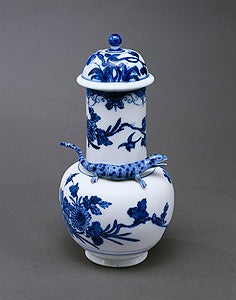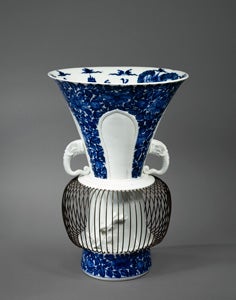The Arnhold Collection of Meissen Porcelain, 1710–50
March 25, 2008, through June 29, 2008
Images from the Exhibition: First | Next | Last
| |
 |
| |
Vase and Cover, Meissen porcelain, c. 1725,
2001.462; H., 9 1/4” (23.5 cm). Photo: Maggie Nimkin |
Among the most popular Chinese porcelains exported to Europe were those with a cobalt-blue painted decoration under the glaze. A decidedly royal taste, many imitations were made at Meissen in the early years. A fine example in the Arnhold Collection is the Vase and Cover, with a floral decoration and a lizard applied around the neck, copying Asian prototypes. This vase is listed in the inventory of the Japanese Palace and was one of eight made for the king. The taste for kakiemon and blue-and-white wares from Japan was also strong.
In 1730, August II commissioned the Meissen factory to make one hundred “birdcage” vases, for the decoration of the Japanese Palace. Copies of an unusual Japanese export confection, these pieces have a trumpet-shaped form with elephant-head handles and a base surrounded by a wire cage meant to contain porcelain birds on the modeled rock outcroppings and branches.
 |
|
| One of a Pair of Birdcage Vases,
Meissen porcelain, after 1730, 2000.416,
20 ¼” (51.4 cm). Photo: Maggie Nimkin |
|
Twenty-one of the Meissen vases were ready for firing in 1731, although it is not known how many were made altogether. The pair acquired by Henry Arnhold in 2000 are extremely rare survivors of this extraordinary series and derive from the collection of the kings of Italy.
>>> Next image from the exhibition.
The Arnhold Collection of Meissen Porcelain, 1710–50, was organized for The Frick Collection by Director Anne L. Poulet and Maureen Cassidy-Geiger, guest curator of the exhibition. It is accompanied by a fully illustrated catalogue, published by The Frick Collection in association with D Giles Unlimited, London, available in mid-April in the Museum Shop and online at shopfrick.org.
The exhibition is made possible, in part, by the generous support of the Arnhold Foundation.
|


